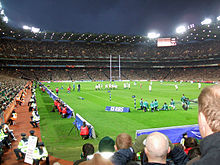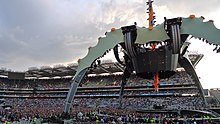-
Out of stock

 Superb Guinness advert publicising their sponsorship of the All Ireland Senior Hurling Championship-unframed print. 44cm x 60cm Guinness were long time sponsors of the All Ireland Senior Hurling Championship.Hurling is an ancient sport ,played for over 2000 years by such mythical Irish legends such as Setanta, who is depicted here in this distinctive Guinness advert fighting off a fierce wolf, armed with just a Hurl and a sliotar! Following on the company’s imaginative marketing and advertising campaigns — with such slogans as ‘Not Men But Giants,’ ‘Nobody Said It Was Going To Be Easy’ and ‘The Stuff of Legend’ — other imaginative adverts brought the message that hurling is part of the Irish DNA. Other campaigns, entitled ‘It’s Alive Inside’ focused on how hurling is an integral part of Irish life and how the love of hurling is alive inside every hurling player and fan.
Superb Guinness advert publicising their sponsorship of the All Ireland Senior Hurling Championship-unframed print. 44cm x 60cm Guinness were long time sponsors of the All Ireland Senior Hurling Championship.Hurling is an ancient sport ,played for over 2000 years by such mythical Irish legends such as Setanta, who is depicted here in this distinctive Guinness advert fighting off a fierce wolf, armed with just a Hurl and a sliotar! Following on the company’s imaginative marketing and advertising campaigns — with such slogans as ‘Not Men But Giants,’ ‘Nobody Said It Was Going To Be Easy’ and ‘The Stuff of Legend’ — other imaginative adverts brought the message that hurling is part of the Irish DNA. Other campaigns, entitled ‘It’s Alive Inside’ focused on how hurling is an integral part of Irish life and how the love of hurling is alive inside every hurling player and fan. -

 Fantastic panoramic photo of the modern Croke Park,one of the most iconic sporting venues in the World. Dimensions: 36cm x110cm Croke Park (Irish: Páirc an Chrócaigh) is a Gaelic games stadium located in Dublin, Ireland. Named after Archbishop Thomas Croke, it is sometimes called Croker by GAA fans and locals. It serves as both the principal stadium and headquarters of the Gaelic Athletic Association (GAA). Since 1891 the site has been used by the GAA to host Gaelic sports, including the annual All-Ireland in Gaelic football and hurling. A major expansion and redevelopment of the stadium ran from 1991–2005, raising capacity to its current 82,300 spectators. This makes Croke Park the third-largest stadium in Europe, and the largest not usually used for association football. Other events held at the stadium include the opening and closing ceremonies of the 2003 Special Olympics, and numerous musical concerts. In 2012, Irish pop group Westlife sold out the stadium in record-breaking time: less than 5 minutes. From 2007–10, Croke Park hosted home matches of the Ireland national rugby union team and the Republic of Ireland national football team, while their new Aviva Stadium was constructed. This use of Croke Park for non-Gaelic sports was controversial and required temporary changes to GAA rules. In June 2012, the stadium hosted the closing ceremony of the 50th International Eucharistic Congress during which Pope Benedict XVI gave an address over video link.
Fantastic panoramic photo of the modern Croke Park,one of the most iconic sporting venues in the World. Dimensions: 36cm x110cm Croke Park (Irish: Páirc an Chrócaigh) is a Gaelic games stadium located in Dublin, Ireland. Named after Archbishop Thomas Croke, it is sometimes called Croker by GAA fans and locals. It serves as both the principal stadium and headquarters of the Gaelic Athletic Association (GAA). Since 1891 the site has been used by the GAA to host Gaelic sports, including the annual All-Ireland in Gaelic football and hurling. A major expansion and redevelopment of the stadium ran from 1991–2005, raising capacity to its current 82,300 spectators. This makes Croke Park the third-largest stadium in Europe, and the largest not usually used for association football. Other events held at the stadium include the opening and closing ceremonies of the 2003 Special Olympics, and numerous musical concerts. In 2012, Irish pop group Westlife sold out the stadium in record-breaking time: less than 5 minutes. From 2007–10, Croke Park hosted home matches of the Ireland national rugby union team and the Republic of Ireland national football team, while their new Aviva Stadium was constructed. This use of Croke Park for non-Gaelic sports was controversial and required temporary changes to GAA rules. In June 2012, the stadium hosted the closing ceremony of the 50th International Eucharistic Congress during which Pope Benedict XVI gave an address over video link.City and Suburban Racecourse
The area now known as Croke Park was owned in the 1880s by Maurice Butterly and known as the City and Suburban Racecourse, or Jones' Road sports ground. From 1890 it was also used by the Bohemian Football Club. In 1901 Jones' Road hosted the IFA Cup football final when Cliftonville defeated Freebooters.History
Recognising the potential of the Jones' Road sports ground a journalist and GAA member, Frank Dineen, borrowed much of the £3,250 asking price and bought the ground in 1908. In 1913 the GAA came into exclusive ownership of the plot when they purchased it from Dineen for £3,500. The ground was then renamed Croke Park in honour of Archbishop Thomas Croke, one of the GAA's first patrons. In 1913, Croke Park had only two stands on what is now known as the Hogan stand side and grassy banks all round. In 1917, a grassy hill was constructed on the railway end of Croke Park to afford patrons a better view of the pitch. This terrace was known originally as Hill 60, later renamed Hill 16 in memory of the 1916 Easter Rising. It is erroneously believed to have been built from the ruins of the GPO, when it was constructed the previous year in 1915. In the 1920s, the GAA set out to create a high capacity stadium at Croke Park. Following the Hogan Stand, the Cusack Stand, named after Michael Cusack from Clare (who founded the GAA and served as its first secretary), was built in 1927. 1936 saw the first double-deck Cusack Stand open with 5,000 seats, and concrete terracing being constructed on Hill 16. In 1952 the Nally Stand was built in memorial of Pat Nally, another of the GAA founders. Seven years later, to celebrate the 75th anniversary of the GAA, the first cantilevered "New Hogan Stand" was opened. The highest attendance ever recorded at an All-Ireland Senior Football Championship Final was 90,556 for Offaly v Down in 1961. Since the introduction of seating to the Cusack stand in 1966, the largest crowd recorded has been 84,516.Bloody Sunday
During the Irish War of Independence on 21 November 1920 Croke Park was the scene of a massacre by the Royal Irish Constabulary (RIC). The Police, supported by the British Auxiliary Division, entered the ground and began shooting into the crowd, killing or fatally wounding 14 civilians during a Dublin-Tipperary Gaelic football match. The dead included 13 spectators and Tipperary player Michael Hogan. Posthumously, the Hogan stand built in 1924 was named in his honour. These shootings, on the day which became known as Bloody Sunday, were a reprisal for the killing of 15 people associated with the Cairo Gang, a group of British Intelligence officers, by Michael Collins' 'squad' earlier that day.Dublin Rodeo
In 1924, American rodeo promoter, Tex Austin, staged the Dublin Rodeo, Ireland's first professional rodeo at Croke Park Stadium. For seven days, with two shows each day from August 18 to August 24, sell out crowds saw cowboys and cowgirls from Canada, the United States, Mexico, Argentina and Australia compete for rodeo championship titles.Canadian bronc riders such as Andy Lund and his brother Art Lund, trick riders such as Ted Elder and Vera McGinnis were among the contestants. British Pathe filmed some of the rodeo events.Stadium design
In 1984 the organisation decided to investigate ways to increase the capacity of the old stadium. The design for an 80,000 capacity stadium was completed in 1991. Gaelic sports have special requirements as they take place on a large field. A specific requirement was to ensure the spectators were not too far from the field of play. This resulted in the three-tier design from which viewing games is possible: the main concourse, a premium level incorporating hospitality facilities and an upper concourse. The premium level contains restaurants, bars and conference areas. The project was split into four phases over a 14-year period. Such was the importance of Croke Park to the GAA for hosting big games, the stadium did not close during redevelopment. During each phase different parts of the ground were redeveloped, while leaving the rest of the stadium open. Big games, including the annual All-Ireland Hurling and Football finals, were played in the stadium throughout the development.Phase one – New Cusack Stand
The first phase of construction was to build a replacement for Croke Park's Cusack Stand. A lower deck opened for use in 1994. The upper deck opened in 1995. Completed at a cost of £35 million, the new stand is 180 metres long, 35 metres high, has a capacity for 27,000 people and contains 46 hospitality suites. The new Cusack Stand contains three tiers from which viewing games is possible: the main concourse, a premium level incorporating hospitality facilities and finally an upper concourse. One end of the pitch was closer to the stand after this phase, as the process of slightly re-aligning the pitch during the redevelopment of the stadium began. The works were carried out by Sisk Group.Phase two – Davin Stand
Phase Two of the development started in late 1998 and involved extending the new Cusack Stand to replace the existing Canal End terrace. It involved reacquiring a rugby pitch that had been sold to Belvedere College in 1910 by Frank Dineen. In payment and part exchange, the college was given the nearby Distillery Road sportsgrounds.[19] It is now known as The Davin Stand (Irish: Ardán Dáimhím), after Maurice Davin, the first president of the GAA. This phase also saw the creation of a tunnel which was later named the Ali tunnel in honour of Muhammad Ali and his fight against Al Lewis in July 1972 in Croke Park.Phase three – Hogan Stand
Phase Three saw the building of the new Hogan Stand. This required a greater variety of spectator categories to be accommodated including general spectators, corporate patrons, VIPs, broadcast and media services and operation staff. Extras included a fitted-out mezzanine level for VIP and Ard Comhairle (Where the dignitaries sit) along with a top-level press media facility. The end of Phase Three took the total spectator capacity of Croke Park to 82,000.Phase four – Nally Stand & Nally End/Dineen Hill 16 terrace
After the 2003 Special Olympics, construction began in September 2003 on the final phase, Phase Four. This involved the redevelopment of the Nally Stand, named after the athlete Pat Nally, and Hill 16 into a new Nally End/Dineen Hill 16 terrace. While the name Nally had been used for the stand it replaced, the use of the name Dineen was new, and was in honour of Frank Dineen, who bought the original stadium for the GAA in 1908, giving it to them in 1913. The old Nally Stand was taken away and reassembled in Pairc Colmcille, home of Carrickmore GAA in County Tyrone. The phase four development was officially opened by the then GAA President Seán Kelly on 14 March 2005. For logistical reasons (and, to a degree, historical reasons), and also to provide cheaper high-capacity space, the area is a terrace rather than a seated stand, the only remaining standing-room in Croke Park. Unlike the previous Hill, the new terrace was divided into separate sections – Hill A (Cusack stand side), Hill B (behind the goals) and the Nally terrace (on the site of the old Nally Stand). The fully redeveloped Hill has a capacity of around 13,200, bringing the overall capacity of the stadium to 82,300. This made the stadium the second biggest in the EU after the Camp Nou, Barcelona. However, London's new Wembley stadium has since overtaken Croke Park in second place. The presence of terracing meant that for the brief period when Croke Park hosted international association football during 2007–2009, the capacity was reduced to approximately 73,500, due to FIFA's statutes stating that competitive games must be played in all-seater stadiums.Pitch
The pitch in Croke Park is a soil pitch that replaced the Desso GrassMaster pitch laid in 2002. This replacement was made after several complaints by players and managers that the pitch was excessively hard and far too slippery. Since January 2006, a special growth and lighting system called the SGL Concept has been used to assist grass growing conditions, even in the winter months. The system, created by Dutch company SGL (Stadium Grow Lighting), helps in controlling and managing all pitch growth factors, such as light, temperature, CO2, water, air and nutrients.Floodlighting
With the 2007 Six Nations clash with France and possibly other matches in subsequent years requiring lighting the GAA installed floodlights in the stadium (after planning permission was granted). Indeed, many other GAA grounds around the country have started to erect floodlights as the organisation starts to hold games in the evenings, whereas traditionally major matches were played almost exclusively on Sunday afternoons. The first game to be played under these lights at Croke Park was a National Football League Division One match between Dublin and Tyrone on 3 February 2007 with Tyrone winning in front of a capacity crowd of over 81,000 – which remains a record attendance for a National League game, with Ireland's Six Nations match with France following on 11 February. Temporary floodlights were installed for the American Bowl game between Chicago Bears and Pittsburgh Steelers on the pitch in 1997, and again for the 2003 Special Olympics.Concert
Date Performer(s) Opening act(s) Tour/Event Attendance Notes 29 June 1985 U2 In Tua Nua, R.E.M., The Alarm, Squeeze The Unforgettable Fire Tour 57,000 First Irish act to have a headline concert. Part of the concert was filmed for the group's documentary Wide Awake in Dublin. 28 June 1986 Simple Minds Once Upon A Time Tour Guest appearance by Bono 27 June 1987 U2 Light A Big Fire, The Dubliners, The Pogues, Lou Reed The Joshua Tree Tour 114,000 28 June 1987 Christy Moore, The Pretenders, Lou Reed, Hothouse Flowers 28 June 1996 Tina Turner Brian Kennedy Wildest Dreams Tour 40,000/40,000 16 May 1997 Garth Brooks World Tour II 18 May 1997 29 May 1998 Elton John & Billy Joel Face to Face 1998 30 May 1998 24 June 2005 U2 The Radiators from Space, The Thrills, The Bravery, Snow Patrol, Paddy Casey, Ash Vertigo Tour 246,743 25 June 2005 27 June 2005 20 May 2006 Bon Jovi Nickelback Have a Nice Day Tour 81,327 9 June 2006 Robbie Williams Basement Jaxx Close Encounters Tour 6 October 2007 The Police Fiction Plane The Police Reunion Tour 81,640 Largest attendance of the tour. 31 May 2008 Celine Dion Il Divo Taking Chances World Tour 69,725 Largest attendance for a solo female act 1 June 2008 Westlife Shayne Ward Back Home Tour 85,000 Second Irish act to have a headline concert. Largest attendance of the tour. Part of the concert was filmed for the group's documentary and concert DVD 10 Years of Westlife - Live at Croke Park Stadium. 14 June 2008 Neil Diamond 13 June 2009 Take That The Script Take That Present: The Circus Live 24 July 2009 U2 Glasvegas, Damien Dempsey U2 360° Tour 243,198 25 July 2009 Kaiser Chiefs, Republic of Loose 27 July 2009 Bell X1, The Script The performances of "New Year's Day" and "I'll Go Crazy If I Don't Go Crazy Tonight" were recorded for the group's live album U22 and for the band's remix album Artificial Horizon and the live EP Wide Awake in Europe, respectively. 5 June 2010 Westlife Wonderland, WOW, JLS, Jedward Where We Are Tour 86,500 Largest attendance of the tour. 18 June 2011 Take That Pet Shop Boys Progress Live 154,828 19 June 2011 22 June 2012 Westlife Jedward, The Wanted, Lawson Greatest Hits Tour 187,808[24] The 23 June 2012 date broke the stadium record for selling out its tickets in four minutes. Eleventh largest attendance at an outdoor stadium worldwide. Largest attendance of the tour and the band's music career history. Part of the concert was filmed for the group's documentary and concert DVD The Farewell Tour - Live in Croke Park. 23 June 2012 26 June 2012 Red Hot Chili Peppers Noel Gallagher's High Flying Birds, The Vaccines I'm with You World Tour 23 May 2014 One Direction 5 Seconds of Summer Where We Are Tour 235,008 24 May 2014 25 May 2014 20 June 2015 The Script & Pharrell Williams No Sound Without Silence Tour 74,635 24 July 2015 Ed Sheeran x Tour 162,308 25 July 2015 27 May 2016 Bruce Springsteen The River Tour 2016 160,188 29 May 2016 9 July 2016 Beyoncé Chloe x Halle, Ingrid Burley The Formation World Tour 68,575 8 July 2017 Coldplay AlunaGeorge, Tove Lo A Head Full of Dreams Tour[25] 80,398 22 July 2017 U2 Noel Gallagher's High Flying Birds The Joshua Tree Tour 2017 80,901 17 May 2018 The Rolling Stones The Academic No Filter Tour 64,823 15 June 2018 Taylor Swift Camila Cabello, Charli XCX Taylor Swift's Reputation Stadium Tour 136.000 Swift became the first woman headline two concerts in a row there. 16 June 2018 7 July 2018 Michael Bublé Emeli Sandé 24 May 2019 Spice Girls Jess Glynne Spice World - 2019 UK Tour 5 July 2019 Westlife James Arthur Wild Youth The 20 Touror The Twenty Tour The 5 July 2019 date sold out its tickets in six minutes. Second date released were also sold out in under forty-eight hours. 6 July 2019 Non-Gaelic games
There was great debate in Ireland regarding the use of Croke Park for sports other than those of the GAA. As the GAA was founded as a nationalist organisation to maintain and promote indigenous Irish sport, it has felt honour-bound throughout its history to oppose other, foreign (in practice, British), sports. In turn, nationalist groups supported the GAA as the prime example of purely Irish sporting culture. Until its abolition in 1971, rule 27 of the GAA constitution stated that a member of the GAA could be banned from playing its games if found to be also playing association football, rugby or cricket. That rule was abolished but rule 42 still prohibited the use of GAA property for games with interests in conflict with the interests of the GAA. The belief was that rugby and association football were in competition with Gaelic football and hurling, and that if the GAA allowed these sports to use their ground it might be harmful to Gaelic games, while other sports, not seen as direct competitors with Gaelic football and hurling, were permitted, such as the two games of American football (Croke Park Classic college football game between The University of Central Florida and Penn State, and an American Bowl NFL preseason game between the Chicago Bears and the Pittsburgh Steelers) on the Croke Park pitch during the 1990s.[27] On 16 April 2005, a motion to temporarily relax rule No. 42 was passed at the GAA Annual Congress. The motion gives the GAA Central Council the power to authorise the renting or leasing of Croke Park for events other than those controlled by the Association, during a period when Lansdowne Road – the venue for international soccer and rugby matches – was closed for redevelopment. The final result was 227 in favour of the motion to 97 against, 11 votes more than the required two-thirds majority. In January 2006, it was announced that the GAA had reached agreement with the Football Association of Ireland (FAI) and Irish Rugby Football Union (IRFU) to stage two Six Nations games and four soccer internationals at Croke Park in 2007 and in February 2007, use of the pitch by the FAI and the IRFU in 2008 was also agreed.These agreements were within the temporary relaxation terms, as Lansdowne Road was still under redevelopment until 2010. Although the GAA had said that hosted use of Croke Park would not extend beyond 2008, irrespective of the redevelopment progress, fixtures for the 2009 Six Nations rugby tournament saw the Irish rugby team using Croke park for a third season. 11 February 2007 saw the first rugby union international to be played there. Ireland were leading France in a Six Nations clash, but lost 17–20 after conceding a last minute (converted) try. Raphael Ibanez scored the first try in that match; Ronan O'Gara scored Ireland's first ever try in Croke Park. A second match between Ireland and England on 24 February 2007 was politically symbolic because of the events of Bloody Sunday in 1920.There was considerable concern as to what reaction there would be to the singing of the British national anthem "God Save the Queen". Ultimately the anthem was sung without interruption or incident, and applauded by both sets of supporters at the match, which Ireland won by 43–13 (their largest ever win over England in rugby). On 2 March 2010, Ireland played their final international rugby match against a Scotland team that was playing to avoid the wooden spoon and hadn't won a championship match against Ireland since 2001. Outside half, Dan Parks inspired the Scots to a 3-point victory and ended Irish Hopes of a triple crown. On 24 March 2007, the first association football match took place at Croke Park. The Republic of Ireland took on Wales in UEFA Euro 2008 qualifying Group D, with a Stephen Ireland goal securing a 1–0 victory for the Irish in front of a crowd of 72,500. Prior to this, the IFA Cup had been played at the then Jones' Road in 1901, but this was 12 years before the GAA took ownership. Negotiations took place for the NFL International Series's 2011 game to be held at Croke Park but the game was awarded to Wembley Stadium.World record attendance
On 2 May 2009, Croke Park was the venue for a Heineken Cup rugby semi-final, in which Leinster defeated Munster 25–6. The attendance of 82,208 set a new world record attendance for a club rugby union game.[35] This record stood until 31 March 2012 when it was surpassed by an English Premiership game between Harlequins and Saracens at Wembley Stadium which hosted a crowd of 83,761.This was beaten again in 2016 in the Top 14 final at the Nou Camp which hosted a crowd of 99,124Skyline tour
A walkway, known under a sponsorship deal as Etihad Skyline Croke Park, opened on 1 June 2012.From 44 metres above the ground, it offers views of Dublin city and the surrounding area.The Olympic Torch was brought to the stadium and along the walkway on 6 June 2012.GAA Hall of Fame
On 11 February 2013, the GAA opened the Hall of Fame section in the Croke Park museum. The foundation of the award scheme is the Teams of the Millennium the football team which was announced in 1999 and the hurling team in 2000 and all 30 players were inducted into the hall of fame along with Limerick hurler Eamonn Cregan and Offaly footballer Tony McTague who were chosen by a GAA sub-committee from the years 1970–74.New inductees will be chosen on an annual basis from the succeeding five-year intervals as well as from years preceding 1970. In April 2014, Kerry legend Mick O'Dwyer, Sligo footballer Micheál Kerins, along with hurlers Noel Skehan of Kilkenny and Pat McGrath of Waterford became the second group of former players to receive hall of fame awards. Statue of Michael Cusack outside the Croke Park GAA Museum
Statue of Michael Cusack outside the Croke Park GAA Museum -

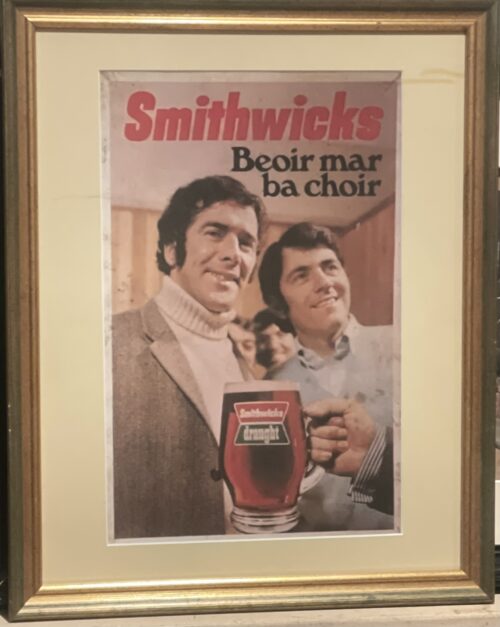 50cm x 40cm Smithwick's brewery was founded in Kilkenny in 1710 by John Smithwick and run by the Smithwick family of Kilkenny until 1965 when it was acquired by Guinness, now part of Diageo. The Kilkenny brewery was shut down in 2013 and production of all Smithwick's and Kilkenny branded beers moved to Dublin; parts of the old brewery are now a "visitor experience". Smithwick's Brewery was founded by John Smithwick in 1710. The brewery is on the site of a Franciscan abbey, where monks had brewed ale since the 14th century, and ruins of the original abbey still remain on its grounds. The old brewery has since been renovated and now hosts "The Smithwick's Experience Kilkenny" visitor attraction and centre. At the time of its closure, it was Ireland's oldest operating brewery. John Smithwick was an orphan who had settled in Kilkenny. Shortly after his arrival, Smithwick went into the brewing business with Richard Cole on a piece of land that Cole had leased from the Duke of Ormond in 1705. Five years later, John Smithwick became the owner of the land. The brewery stayed small, servicing a loyal local following while John Smithwick diversified. Following John Smithwick's death, the brewery temporarily fell out of family hands. John Smithwick's great-grandson, Edmond bought the brewery land back freehold and worked to reshape its future. Edmond concentrated on discovering new markets and successfully building export trade. Drinkers in England, Scotland and Wales developed a taste for Smithwick's brews and output increased fivefold. As a result of substantial contributions made to St Mary's Cathedral, Edmond became great friends with Irish liberal Daniel O'Connell, who later became godfather to one of his sons. Edmond Smithwick became well known and respected by the people of Kilkenny who elected him town mayor four times. In 1800, export sales began to fall and the brewing industry encountered difficulty. To combat this, the Smithwick family increased production in their maltings, began selling mineral water and delivered butter with the ale from the back of their drays. By 1900, output was at an all-time low and the then owner James Smithwick was advised by auditors to shut the doors of the brewery. Instead, James reduced the range of beers they produced and set out to find new markets. He secured military contracts and soon after saw output increase again. James' son, Walter, took control in 1930 and steered the brewery to success through the hardships of both World War II and increasingly challenging weather conditions. By January 1950, Smithwick's was exporting ale to Boston. Smithwick's was purchased from Walter Smithwick in 1965 by Guinness and is now, along with Guinness, part of Diageo. Together, Guinness & Co. and Smithwick's developed and launched Smithwick's Draught Ale in 1966. By 1979, half a million barrels were sold each year. In 1980, Smithwick's began exporting to France. In 1993, Smithwick's Draught became Canada's leading imported ale. By 2010, Smithwick's continued to be brewed in Dundalk and Kilkenny with tankers sent to Dublin to be kegged for the on trade market. Cans and bottles were packaged by IBC in Belfast. Production in the Kilkenny brewery finished on 31 December 2013 and Smithwick's brands are now produced in the Diageo St.James's Gate brewery in Dublin. In 2017 Walter Smithwick's son, Paul, launched Sullivan's Ale with his son, Daniel, which has its home in Kilkenny. The original Kilkenny site was sold to Kilkenny County Council, with a small portion of the site dedicated to the opening of a visitor's centre, the "Smithwick's Experience Kilkenny".
50cm x 40cm Smithwick's brewery was founded in Kilkenny in 1710 by John Smithwick and run by the Smithwick family of Kilkenny until 1965 when it was acquired by Guinness, now part of Diageo. The Kilkenny brewery was shut down in 2013 and production of all Smithwick's and Kilkenny branded beers moved to Dublin; parts of the old brewery are now a "visitor experience". Smithwick's Brewery was founded by John Smithwick in 1710. The brewery is on the site of a Franciscan abbey, where monks had brewed ale since the 14th century, and ruins of the original abbey still remain on its grounds. The old brewery has since been renovated and now hosts "The Smithwick's Experience Kilkenny" visitor attraction and centre. At the time of its closure, it was Ireland's oldest operating brewery. John Smithwick was an orphan who had settled in Kilkenny. Shortly after his arrival, Smithwick went into the brewing business with Richard Cole on a piece of land that Cole had leased from the Duke of Ormond in 1705. Five years later, John Smithwick became the owner of the land. The brewery stayed small, servicing a loyal local following while John Smithwick diversified. Following John Smithwick's death, the brewery temporarily fell out of family hands. John Smithwick's great-grandson, Edmond bought the brewery land back freehold and worked to reshape its future. Edmond concentrated on discovering new markets and successfully building export trade. Drinkers in England, Scotland and Wales developed a taste for Smithwick's brews and output increased fivefold. As a result of substantial contributions made to St Mary's Cathedral, Edmond became great friends with Irish liberal Daniel O'Connell, who later became godfather to one of his sons. Edmond Smithwick became well known and respected by the people of Kilkenny who elected him town mayor four times. In 1800, export sales began to fall and the brewing industry encountered difficulty. To combat this, the Smithwick family increased production in their maltings, began selling mineral water and delivered butter with the ale from the back of their drays. By 1900, output was at an all-time low and the then owner James Smithwick was advised by auditors to shut the doors of the brewery. Instead, James reduced the range of beers they produced and set out to find new markets. He secured military contracts and soon after saw output increase again. James' son, Walter, took control in 1930 and steered the brewery to success through the hardships of both World War II and increasingly challenging weather conditions. By January 1950, Smithwick's was exporting ale to Boston. Smithwick's was purchased from Walter Smithwick in 1965 by Guinness and is now, along with Guinness, part of Diageo. Together, Guinness & Co. and Smithwick's developed and launched Smithwick's Draught Ale in 1966. By 1979, half a million barrels were sold each year. In 1980, Smithwick's began exporting to France. In 1993, Smithwick's Draught became Canada's leading imported ale. By 2010, Smithwick's continued to be brewed in Dundalk and Kilkenny with tankers sent to Dublin to be kegged for the on trade market. Cans and bottles were packaged by IBC in Belfast. Production in the Kilkenny brewery finished on 31 December 2013 and Smithwick's brands are now produced in the Diageo St.James's Gate brewery in Dublin. In 2017 Walter Smithwick's son, Paul, launched Sullivan's Ale with his son, Daniel, which has its home in Kilkenny. The original Kilkenny site was sold to Kilkenny County Council, with a small portion of the site dedicated to the opening of a visitor's centre, the "Smithwick's Experience Kilkenny".Smithwick Family
Walter and Eileen Smithwick had 6 children; Judge Peter Smithwick, Michael, Anne, Judy, Paul and John. Judge Peter Smithwick (born 1937) is an Irish judge, and Chairman and Sole Member of the Smithwick Tribunal, a Tribunal of Inquiry into the events surrounding the killing of Chief Superintendent Harry Breen and Superintendent Robert Buchanan of the Royal Ulster Constabulary (RUC). Paul Smithwick (born 1943) launched Sullivan's Ale in 2016 with his son Daniel. His eldest daughter Emma Smithwick is a well-known TV producer in London. His daughter Georgina is a technology entrepreneur, named by Sunday Times as Top 100 Innovators in Great Britain.Sullivan's Brewery
In the Old Kilkenny Review, year unknown, Peter Smithwick, K.M., Solicitor, wrote that the tradition in Kilkenny is that Sullivan's Brewery was founded in 1702 by Daniel Sullivan, a Protestant, who bought property in trust for Pierse Bryan of Jenkinstown, a Catholic who was prohibited by the Penal Laws from buying land. The property, on the West side of High Street, "standing backwards in James's Street", is believed to have been the site of Sullivan's Brewery, the forerunner of Smithwicks. -

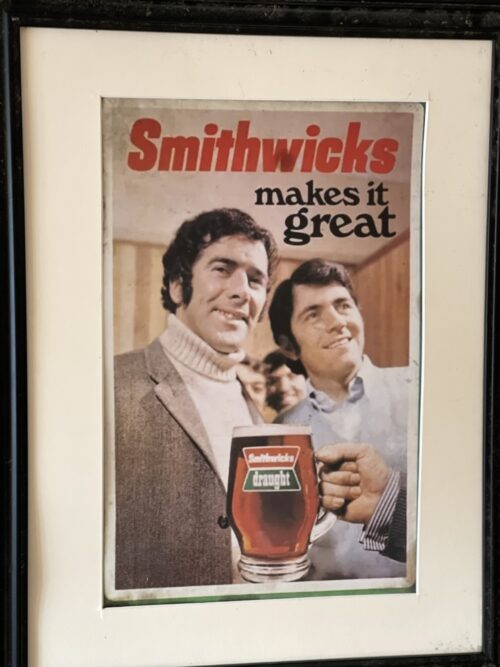 Nice 1970s era retro Smithwicks makes it great advert Dimensions :60cm x 45cm Smithwick's brewery was founded in Kilkenny in 1710 by John Smithwick and run by the Smithwick family of Kilkenny until 1965 when it was acquired by Guinness, now part of Diageo. The Kilkenny brewery was shut down in 2013 and production of all Smithwick's and Kilkenny branded beers moved to Dublin; parts of the old brewery are now a "visitor experience". Smithwick's Brewery was founded by John Smithwick in 1710. The brewery is on the site of a Franciscan abbey, where monks had brewed ale since the 14th century, and ruins of the original abbey still remain on its grounds. The old brewery has since been renovated and now hosts "The Smithwick's Experience Kilkenny" visitor attraction and centre. At the time of its closure, it was Ireland's oldest operating brewery. John Smithwick was an orphan who had settled in Kilkenny. Shortly after his arrival, Smithwick went into the brewing business with Richard Cole on a piece of land that Cole had leased from the Duke of Ormond in 1705. Five years later, John Smithwick became the owner of the land. The brewery stayed small, servicing a loyal local following while John Smithwick diversified. Following John Smithwick's death, the brewery temporarily fell out of family hands. John Smithwick's great-grandson, Edmond bought the brewery land back freehold and worked to reshape its future. Edmond concentrated on discovering new markets and successfully building export trade. Drinkers in England, Scotland and Wales developed a taste for Smithwick's brews and output increased fivefold. As a result of substantial contributions made to St Mary's Cathedral, Edmond became great friends with Irish liberal Daniel O'Connell, who later became godfather to one of his sons. Edmond Smithwick became well known and respected by the people of Kilkenny who elected him town mayor four times. In 1800, export sales began to fall and the brewing industry encountered difficulty. To combat this, the Smithwick family increased production in their maltings, began selling mineral water and delivered butter with the ale from the back of their drays. By 1900, output was at an all-time low and the then owner James Smithwick was advised by auditors to shut the doors of the brewery. Instead, James reduced the range of beers they produced and set out to find new markets. He secured military contracts and soon after saw output increase again. James' son, Walter, took control in 1930 and steered the brewery to success through the hardships of both World War II and increasingly challenging weather conditions. By January 1950, Smithwick's was exporting ale to Boston. Smithwick's was purchased from Walter Smithwick in 1965 by Guinness and is now, along with Guinness, part of Diageo. Together, Guinness & Co. and Smithwick's developed and launched Smithwick's Draught Ale in 1966. By 1979, half a million barrels were sold each year. In 1980, Smithwick's began exporting to France. In 1993, Smithwick's Draught became Canada's leading imported ale. By 2010, Smithwick's continued to be brewed in Dundalk and Kilkenny with tankers sent to Dublin to be kegged for the on trade market. Cans and bottles were packaged by IBC in Belfast. Production in the Kilkenny brewery finished on 31 December 2013 and Smithwick's brands are now produced in the Diageo St.James's Gate brewery in Dublin. In 2017 Walter Smithwick's son, Paul, launched Sullivan's Ale with his son, Daniel, which has its home in Kilkenny. The original Kilkenny site was sold to Kilkenny County Council, with a small portion of the site dedicated to the opening of a visitor's centre, the "Smithwick's Experience Kilkenny".
Nice 1970s era retro Smithwicks makes it great advert Dimensions :60cm x 45cm Smithwick's brewery was founded in Kilkenny in 1710 by John Smithwick and run by the Smithwick family of Kilkenny until 1965 when it was acquired by Guinness, now part of Diageo. The Kilkenny brewery was shut down in 2013 and production of all Smithwick's and Kilkenny branded beers moved to Dublin; parts of the old brewery are now a "visitor experience". Smithwick's Brewery was founded by John Smithwick in 1710. The brewery is on the site of a Franciscan abbey, where monks had brewed ale since the 14th century, and ruins of the original abbey still remain on its grounds. The old brewery has since been renovated and now hosts "The Smithwick's Experience Kilkenny" visitor attraction and centre. At the time of its closure, it was Ireland's oldest operating brewery. John Smithwick was an orphan who had settled in Kilkenny. Shortly after his arrival, Smithwick went into the brewing business with Richard Cole on a piece of land that Cole had leased from the Duke of Ormond in 1705. Five years later, John Smithwick became the owner of the land. The brewery stayed small, servicing a loyal local following while John Smithwick diversified. Following John Smithwick's death, the brewery temporarily fell out of family hands. John Smithwick's great-grandson, Edmond bought the brewery land back freehold and worked to reshape its future. Edmond concentrated on discovering new markets and successfully building export trade. Drinkers in England, Scotland and Wales developed a taste for Smithwick's brews and output increased fivefold. As a result of substantial contributions made to St Mary's Cathedral, Edmond became great friends with Irish liberal Daniel O'Connell, who later became godfather to one of his sons. Edmond Smithwick became well known and respected by the people of Kilkenny who elected him town mayor four times. In 1800, export sales began to fall and the brewing industry encountered difficulty. To combat this, the Smithwick family increased production in their maltings, began selling mineral water and delivered butter with the ale from the back of their drays. By 1900, output was at an all-time low and the then owner James Smithwick was advised by auditors to shut the doors of the brewery. Instead, James reduced the range of beers they produced and set out to find new markets. He secured military contracts and soon after saw output increase again. James' son, Walter, took control in 1930 and steered the brewery to success through the hardships of both World War II and increasingly challenging weather conditions. By January 1950, Smithwick's was exporting ale to Boston. Smithwick's was purchased from Walter Smithwick in 1965 by Guinness and is now, along with Guinness, part of Diageo. Together, Guinness & Co. and Smithwick's developed and launched Smithwick's Draught Ale in 1966. By 1979, half a million barrels were sold each year. In 1980, Smithwick's began exporting to France. In 1993, Smithwick's Draught became Canada's leading imported ale. By 2010, Smithwick's continued to be brewed in Dundalk and Kilkenny with tankers sent to Dublin to be kegged for the on trade market. Cans and bottles were packaged by IBC in Belfast. Production in the Kilkenny brewery finished on 31 December 2013 and Smithwick's brands are now produced in the Diageo St.James's Gate brewery in Dublin. In 2017 Walter Smithwick's son, Paul, launched Sullivan's Ale with his son, Daniel, which has its home in Kilkenny. The original Kilkenny site was sold to Kilkenny County Council, with a small portion of the site dedicated to the opening of a visitor's centre, the "Smithwick's Experience Kilkenny".Smithwick Family
Walter and Eileen Smithwick had 6 children; Judge Peter Smithwick, Michael, Anne, Judy, Paul and John. Judge Peter Smithwick (born 1937) is an Irish judge, and Chairman and Sole Member of the Smithwick Tribunal, a Tribunal of Inquiry into the events surrounding the killing of Chief Superintendent Harry Breen and Superintendent Robert Buchanan of the Royal Ulster Constabulary (RUC). Paul Smithwick (born 1943) launched Sullivan's Ale in 2016 with his son Daniel. His eldest daughter Emma Smithwick is a well-known TV producer in London. His daughter Georgina is a technology entrepreneur, named by Sunday Times as Top 100 Innovators in Great Britain.Sullivan's Brewery
In the Old Kilkenny Review, year unknown, Peter Smithwick, K.M., Solicitor, wrote that the tradition in Kilkenny is that Sullivan's Brewery was founded in 1702 by Daniel Sullivan, a Protestant, who bought property in trust for Pierse Bryan of Jenkinstown, a Catholic who was prohibited by the Penal Laws from buying land. The property, on the West side of High Street, "standing backwards in James's Street", is believed to have been the site of Sullivan's Brewery, the forerunner of Smithwicks. -
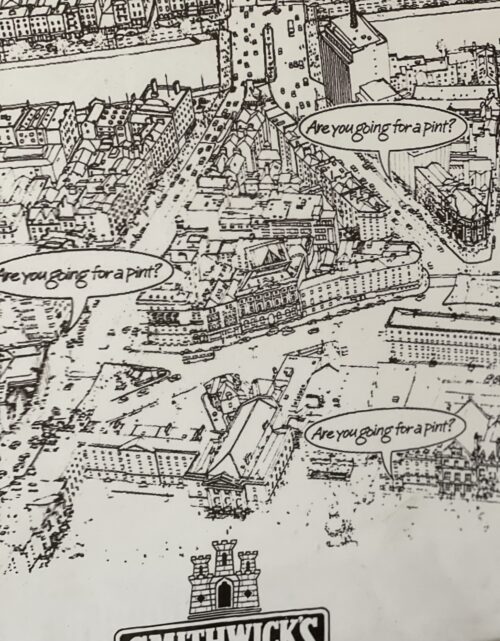
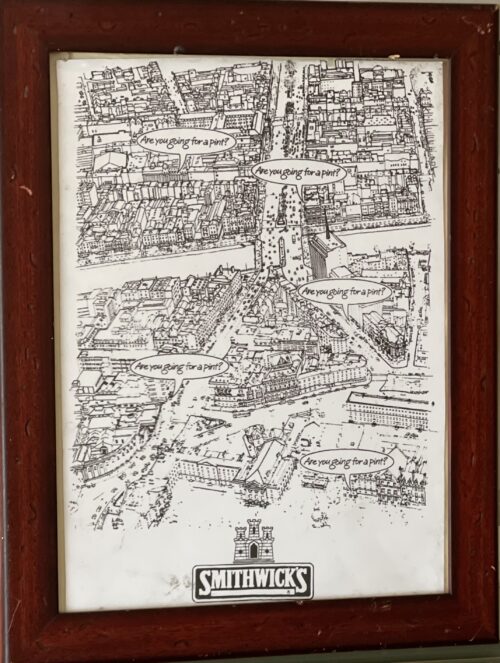 45cm x 34cm The old Smithwicks brewery is on the site of a Franciscan abbey, where monks had brewed ale since the 14th century, and ruins of the original abbey still remain on its grounds. The old brewery has since been renovated and now hosts "The Smithwick's Experience Kilkenny" visitor attraction and centre.At the time of its closure, it was Ireland's oldest operating brewery. John Smithwick was an orphan who had settled in Kilkenny. Shortly after his arrival, Smithwick went into the brewing business with Richard Cole on a piece of land that Cole had leased from the Duke of Ormond in 1705. Five years later, John Smithwick became the owner of the land. The brewery stayed small, servicing a loyal local following while John Smithwick diversified. Following John Smithwick's death, the brewery temporarily fell out of family hands. John Smithwick's great grandson, Edmond bought the brewery land back freehold and worked to reshape its future. Edmond concentrated on discovering new markets and successfully building export trade. Drinkers in England, Scotland and Wales developed a taste for Smithwick's brews and output increased fivefold. As a result of substantial contributions made to St Mary's Cathedral, Edmond became great friends with Irish liberal Daniel O'Connell, who later became godfather to one of his sons. Edmond Smithwick became well known and respected by the people of Kilkenny who elected him town mayor four times. In 1800, export sales began to fall and the brewing industry encountered difficulty. To combat this, the Smithwick family increased production in their maltings, began selling mineral water and delivered butter with the ale from the back of their drays.By 1900, output was at an all-time low and the then owner James Smithwick was advised by auditors to shut the doors of the brewery. Instead, James reduced the range of beers they produced and set out to find new markets. He secured military contracts and soon after saw output increase again. James' son, Walter, took control in 1930 and steered the brewery to success through the hardships of both World War II and increasingly challenging weather conditions.By January 1950, Smithwick's was exporting ale to Boston.Smithwick's was purchased from Walter Smithwick in 1965 by Guinness and is now, along with Guinness, part of Diageo. Together, Guinness & Co. and Smithwick's developed and launched Smithwick's Draught Ale in 1966. By 1979, half a million barrels were sold each year.In 1980, Smithwick's began exporting to France. In 1993, Smithwick's Draught became Canada's leading imported ale.By 2010, Smithwick's continued to be brewed in Dundalk and Kilkenny with tankers sent to Dublin to be kegged for the on trade market. Cans and bottles were packaged by IBC in Belfast.Production in the Kilkenny brewery finished on 31 December 2013 and Smithwicks brands are now produced in the Diageo St.James' Gate brewery in Dublin.The original Kilkenny site was sold to Kilkenny County Council, with a small portion of the site dedicated to the opening of a visitor's centre, the "Smithwick's Experience Kilkenny".
45cm x 34cm The old Smithwicks brewery is on the site of a Franciscan abbey, where monks had brewed ale since the 14th century, and ruins of the original abbey still remain on its grounds. The old brewery has since been renovated and now hosts "The Smithwick's Experience Kilkenny" visitor attraction and centre.At the time of its closure, it was Ireland's oldest operating brewery. John Smithwick was an orphan who had settled in Kilkenny. Shortly after his arrival, Smithwick went into the brewing business with Richard Cole on a piece of land that Cole had leased from the Duke of Ormond in 1705. Five years later, John Smithwick became the owner of the land. The brewery stayed small, servicing a loyal local following while John Smithwick diversified. Following John Smithwick's death, the brewery temporarily fell out of family hands. John Smithwick's great grandson, Edmond bought the brewery land back freehold and worked to reshape its future. Edmond concentrated on discovering new markets and successfully building export trade. Drinkers in England, Scotland and Wales developed a taste for Smithwick's brews and output increased fivefold. As a result of substantial contributions made to St Mary's Cathedral, Edmond became great friends with Irish liberal Daniel O'Connell, who later became godfather to one of his sons. Edmond Smithwick became well known and respected by the people of Kilkenny who elected him town mayor four times. In 1800, export sales began to fall and the brewing industry encountered difficulty. To combat this, the Smithwick family increased production in their maltings, began selling mineral water and delivered butter with the ale from the back of their drays.By 1900, output was at an all-time low and the then owner James Smithwick was advised by auditors to shut the doors of the brewery. Instead, James reduced the range of beers they produced and set out to find new markets. He secured military contracts and soon after saw output increase again. James' son, Walter, took control in 1930 and steered the brewery to success through the hardships of both World War II and increasingly challenging weather conditions.By January 1950, Smithwick's was exporting ale to Boston.Smithwick's was purchased from Walter Smithwick in 1965 by Guinness and is now, along with Guinness, part of Diageo. Together, Guinness & Co. and Smithwick's developed and launched Smithwick's Draught Ale in 1966. By 1979, half a million barrels were sold each year.In 1980, Smithwick's began exporting to France. In 1993, Smithwick's Draught became Canada's leading imported ale.By 2010, Smithwick's continued to be brewed in Dundalk and Kilkenny with tankers sent to Dublin to be kegged for the on trade market. Cans and bottles were packaged by IBC in Belfast.Production in the Kilkenny brewery finished on 31 December 2013 and Smithwicks brands are now produced in the Diageo St.James' Gate brewery in Dublin.The original Kilkenny site was sold to Kilkenny County Council, with a small portion of the site dedicated to the opening of a visitor's centre, the "Smithwick's Experience Kilkenny". -
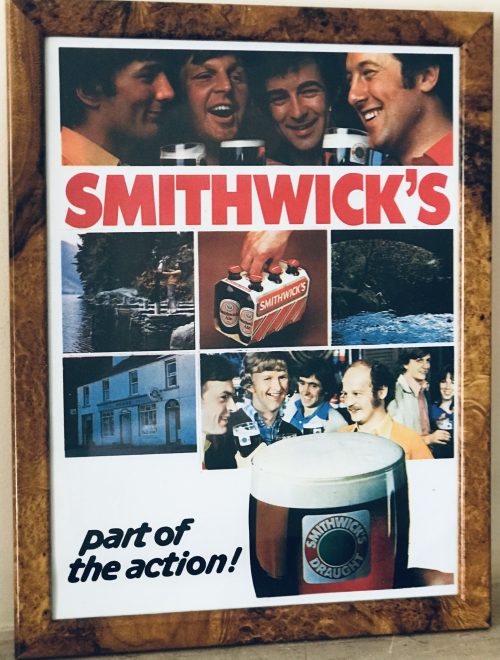
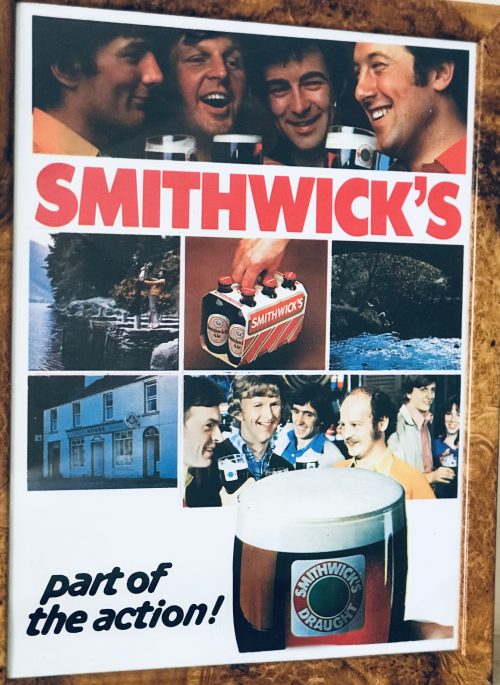 Nice 1970s era retro Smithwicks -part of the action-advert. Dimensions :35cm x 48cm Glazed Smithwick's brewery was founded in Kilkenny in 1710 by John Smithwick and run by the Smithwick family of Kilkenny until 1965 when it was acquired by Guinness, now part of Diageo. The Kilkenny brewery was shut down in 2013 and production of all Smithwick's and Kilkenny branded beers moved to Dublin; parts of the old brewery are now a "visitor experience". Smithwick's Brewery was founded by John Smithwick in 1710. The brewery is on the site of a Franciscan abbey, where monks had brewed ale since the 14th century, and ruins of the original abbey still remain on its grounds. The old brewery has since been renovated and now hosts "The Smithwick's Experience Kilkenny" visitor attraction and centre. At the time of its closure, it was Ireland's oldest operating brewery. John Smithwick was an orphan who had settled in Kilkenny. Shortly after his arrival, Smithwick went into the brewing business with Richard Cole on a piece of land that Cole had leased from the Duke of Ormond in 1705. Five years later, John Smithwick became the owner of the land. The brewery stayed small, servicing a loyal local following while John Smithwick diversified. Following John Smithwick's death, the brewery temporarily fell out of family hands. John Smithwick's great-grandson, Edmond bought the brewery land back freehold and worked to reshape its future. Edmond concentrated on discovering new markets and successfully building export trade. Drinkers in England, Scotland and Wales developed a taste for Smithwick's brews and output increased fivefold. As a result of substantial contributions made to St Mary's Cathedral, Edmond became great friends with Irish liberal Daniel O'Connell, who later became godfather to one of his sons. Edmond Smithwick became well known and respected by the people of Kilkenny who elected him town mayor four times. In 1800, export sales began to fall and the brewing industry encountered difficulty. To combat this, the Smithwick family increased production in their maltings, began selling mineral water and delivered butter with the ale from the back of their drays. By 1900, output was at an all-time low and the then owner James Smithwick was advised by auditors to shut the doors of the brewery. Instead, James reduced the range of beers they produced and set out to find new markets. He secured military contracts and soon after saw output increase again. James' son, Walter, took control in 1930 and steered the brewery to success through the hardships of both World War II and increasingly challenging weather conditions. By January 1950, Smithwick's was exporting ale to Boston. Smithwick's was purchased from Walter Smithwick in 1965 by Guinness and is now, along with Guinness, part of Diageo. Together, Guinness & Co. and Smithwick's developed and launched Smithwick's Draught Ale in 1966. By 1979, half a million barrels were sold each year. In 1980, Smithwick's began exporting to France. In 1993, Smithwick's Draught became Canada's leading imported ale. By 2010, Smithwick's continued to be brewed in Dundalk and Kilkenny with tankers sent to Dublin to be kegged for the on trade market. Cans and bottles were packaged by IBC in Belfast. Production in the Kilkenny brewery finished on 31 December 2013 and Smithwick's brands are now produced in the Diageo St.James's Gate brewery in Dublin. In 2017 Walter Smithwick's son, Paul, launched Sullivan's Ale with his son, Daniel, which has its home in Kilkenny. The original Kilkenny site was sold to Kilkenny County Council, with a small portion of the site dedicated to the opening of a visitor's centre, the "Smithwick's Experience Kilkenny".
Nice 1970s era retro Smithwicks -part of the action-advert. Dimensions :35cm x 48cm Glazed Smithwick's brewery was founded in Kilkenny in 1710 by John Smithwick and run by the Smithwick family of Kilkenny until 1965 when it was acquired by Guinness, now part of Diageo. The Kilkenny brewery was shut down in 2013 and production of all Smithwick's and Kilkenny branded beers moved to Dublin; parts of the old brewery are now a "visitor experience". Smithwick's Brewery was founded by John Smithwick in 1710. The brewery is on the site of a Franciscan abbey, where monks had brewed ale since the 14th century, and ruins of the original abbey still remain on its grounds. The old brewery has since been renovated and now hosts "The Smithwick's Experience Kilkenny" visitor attraction and centre. At the time of its closure, it was Ireland's oldest operating brewery. John Smithwick was an orphan who had settled in Kilkenny. Shortly after his arrival, Smithwick went into the brewing business with Richard Cole on a piece of land that Cole had leased from the Duke of Ormond in 1705. Five years later, John Smithwick became the owner of the land. The brewery stayed small, servicing a loyal local following while John Smithwick diversified. Following John Smithwick's death, the brewery temporarily fell out of family hands. John Smithwick's great-grandson, Edmond bought the brewery land back freehold and worked to reshape its future. Edmond concentrated on discovering new markets and successfully building export trade. Drinkers in England, Scotland and Wales developed a taste for Smithwick's brews and output increased fivefold. As a result of substantial contributions made to St Mary's Cathedral, Edmond became great friends with Irish liberal Daniel O'Connell, who later became godfather to one of his sons. Edmond Smithwick became well known and respected by the people of Kilkenny who elected him town mayor four times. In 1800, export sales began to fall and the brewing industry encountered difficulty. To combat this, the Smithwick family increased production in their maltings, began selling mineral water and delivered butter with the ale from the back of their drays. By 1900, output was at an all-time low and the then owner James Smithwick was advised by auditors to shut the doors of the brewery. Instead, James reduced the range of beers they produced and set out to find new markets. He secured military contracts and soon after saw output increase again. James' son, Walter, took control in 1930 and steered the brewery to success through the hardships of both World War II and increasingly challenging weather conditions. By January 1950, Smithwick's was exporting ale to Boston. Smithwick's was purchased from Walter Smithwick in 1965 by Guinness and is now, along with Guinness, part of Diageo. Together, Guinness & Co. and Smithwick's developed and launched Smithwick's Draught Ale in 1966. By 1979, half a million barrels were sold each year. In 1980, Smithwick's began exporting to France. In 1993, Smithwick's Draught became Canada's leading imported ale. By 2010, Smithwick's continued to be brewed in Dundalk and Kilkenny with tankers sent to Dublin to be kegged for the on trade market. Cans and bottles were packaged by IBC in Belfast. Production in the Kilkenny brewery finished on 31 December 2013 and Smithwick's brands are now produced in the Diageo St.James's Gate brewery in Dublin. In 2017 Walter Smithwick's son, Paul, launched Sullivan's Ale with his son, Daniel, which has its home in Kilkenny. The original Kilkenny site was sold to Kilkenny County Council, with a small portion of the site dedicated to the opening of a visitor's centre, the "Smithwick's Experience Kilkenny".Smithwick Family
Walter and Eileen Smithwick had 6 children; Judge Peter Smithwick, Michael, Anne, Judy, Paul and John. Judge Peter Smithwick (born 1937) is an Irish judge, and Chairman and Sole Member of the Smithwick Tribunal, a Tribunal of Inquiry into the events surrounding the killing of Chief Superintendent Harry Breen and Superintendent Robert Buchanan of the Royal Ulster Constabulary (RUC). Paul Smithwick (born 1943) launched Sullivan's Ale in 2016 with his son Daniel. His eldest daughter Emma Smithwick is a well-known TV producer in London. His daughter Georgina is a technology entrepreneur, named by Sunday Times as Top 100 Innovators in Great Britain.Sullivan's Brewery
In the Old Kilkenny Review, year unknown, Peter Smithwick, K.M., Solicitor, wrote that the tradition in Kilkenny is that Sullivan's Brewery was founded in 1702 by Daniel Sullivan, a Protestant, who bought property in trust for Pierse Bryan of Jenkinstown, a Catholic who was prohibited by the Penal Laws from buying land. The property, on the West side of High Street, "standing backwards in James's Street", is believed to have been the site of Sullivan's Brewery, the forerunner of Smithwicks. -
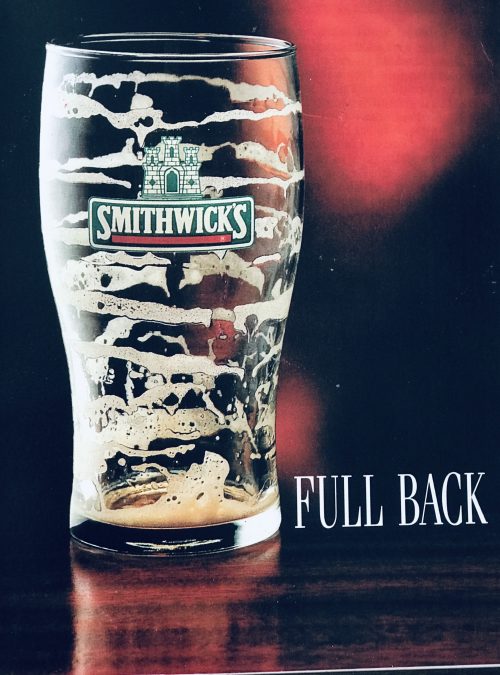
 Nice 90s era retro Smithwicks -Full Back -advert run around the time of the old 5 nations Rugby Tournament. Dimensions :35cm x 48cm Glazed Swords Co Dublin Smithwick's brewery was founded in Kilkenny in 1710 by John Smithwick and run by the Smithwick family of Kilkenny until 1965 when it was acquired by Guinness, now part of Diageo. The Kilkenny brewery was shut down in 2013 and production of all Smithwick's and Kilkenny branded beers moved to Dublin; parts of the old brewery are now a "visitor experience". Smithwick's Brewery was founded by John Smithwick in 1710. The brewery is on the site of a Franciscan abbey, where monks had brewed ale since the 14th century, and ruins of the original abbey still remain on its grounds. The old brewery has since been renovated and now hosts "The Smithwick's Experience Kilkenny" visitor attraction and centre. At the time of its closure, it was Ireland's oldest operating brewery. John Smithwick was an orphan who had settled in Kilkenny. Shortly after his arrival, Smithwick went into the brewing business with Richard Cole on a piece of land that Cole had leased from the Duke of Ormond in 1705. Five years later, John Smithwick became the owner of the land. The brewery stayed small, servicing a loyal local following while John Smithwick diversified. Following John Smithwick's death, the brewery temporarily fell out of family hands. John Smithwick's great-grandson, Edmond bought the brewery land back freehold and worked to reshape its future. Edmond concentrated on discovering new markets and successfully building export trade. Drinkers in England, Scotland and Wales developed a taste for Smithwick's brews and output increased fivefold. As a result of substantial contributions made to St Mary's Cathedral, Edmond became great friends with Irish liberal Daniel O'Connell, who later became godfather to one of his sons. Edmond Smithwick became well known and respected by the people of Kilkenny who elected him town mayor four times. In 1800, export sales began to fall and the brewing industry encountered difficulty. To combat this, the Smithwick family increased production in their maltings, began selling mineral water and delivered butter with the ale from the back of their drays. By 1900, output was at an all-time low and the then owner James Smithwick was advised by auditors to shut the doors of the brewery. Instead, James reduced the range of beers they produced and set out to find new markets. He secured military contracts and soon after saw output increase again. James' son, Walter, took control in 1930 and steered the brewery to success through the hardships of both World War II and increasingly challenging weather conditions. By January 1950, Smithwick's was exporting ale to Boston. Smithwick's was purchased from Walter Smithwick in 1965 by Guinness and is now, along with Guinness, part of Diageo. Together, Guinness & Co. and Smithwick's developed and launched Smithwick's Draught Ale in 1966. By 1979, half a million barrels were sold each year. In 1980, Smithwick's began exporting to France. In 1993, Smithwick's Draught became Canada's leading imported ale. By 2010, Smithwick's continued to be brewed in Dundalk and Kilkenny with tankers sent to Dublin to be kegged for the on trade market. Cans and bottles were packaged by IBC in Belfast. Production in the Kilkenny brewery finished on 31 December 2013 and Smithwick's brands are now produced in the Diageo St.James's Gate brewery in Dublin. In 2017 Walter Smithwick's son, Paul, launched Sullivan's Ale with his son, Daniel, which has its home in Kilkenny. The original Kilkenny site was sold to Kilkenny County Council, with a small portion of the site dedicated to the opening of a visitor's centre, the "Smithwick's Experience Kilkenny".
Nice 90s era retro Smithwicks -Full Back -advert run around the time of the old 5 nations Rugby Tournament. Dimensions :35cm x 48cm Glazed Swords Co Dublin Smithwick's brewery was founded in Kilkenny in 1710 by John Smithwick and run by the Smithwick family of Kilkenny until 1965 when it was acquired by Guinness, now part of Diageo. The Kilkenny brewery was shut down in 2013 and production of all Smithwick's and Kilkenny branded beers moved to Dublin; parts of the old brewery are now a "visitor experience". Smithwick's Brewery was founded by John Smithwick in 1710. The brewery is on the site of a Franciscan abbey, where monks had brewed ale since the 14th century, and ruins of the original abbey still remain on its grounds. The old brewery has since been renovated and now hosts "The Smithwick's Experience Kilkenny" visitor attraction and centre. At the time of its closure, it was Ireland's oldest operating brewery. John Smithwick was an orphan who had settled in Kilkenny. Shortly after his arrival, Smithwick went into the brewing business with Richard Cole on a piece of land that Cole had leased from the Duke of Ormond in 1705. Five years later, John Smithwick became the owner of the land. The brewery stayed small, servicing a loyal local following while John Smithwick diversified. Following John Smithwick's death, the brewery temporarily fell out of family hands. John Smithwick's great-grandson, Edmond bought the brewery land back freehold and worked to reshape its future. Edmond concentrated on discovering new markets and successfully building export trade. Drinkers in England, Scotland and Wales developed a taste for Smithwick's brews and output increased fivefold. As a result of substantial contributions made to St Mary's Cathedral, Edmond became great friends with Irish liberal Daniel O'Connell, who later became godfather to one of his sons. Edmond Smithwick became well known and respected by the people of Kilkenny who elected him town mayor four times. In 1800, export sales began to fall and the brewing industry encountered difficulty. To combat this, the Smithwick family increased production in their maltings, began selling mineral water and delivered butter with the ale from the back of their drays. By 1900, output was at an all-time low and the then owner James Smithwick was advised by auditors to shut the doors of the brewery. Instead, James reduced the range of beers they produced and set out to find new markets. He secured military contracts and soon after saw output increase again. James' son, Walter, took control in 1930 and steered the brewery to success through the hardships of both World War II and increasingly challenging weather conditions. By January 1950, Smithwick's was exporting ale to Boston. Smithwick's was purchased from Walter Smithwick in 1965 by Guinness and is now, along with Guinness, part of Diageo. Together, Guinness & Co. and Smithwick's developed and launched Smithwick's Draught Ale in 1966. By 1979, half a million barrels were sold each year. In 1980, Smithwick's began exporting to France. In 1993, Smithwick's Draught became Canada's leading imported ale. By 2010, Smithwick's continued to be brewed in Dundalk and Kilkenny with tankers sent to Dublin to be kegged for the on trade market. Cans and bottles were packaged by IBC in Belfast. Production in the Kilkenny brewery finished on 31 December 2013 and Smithwick's brands are now produced in the Diageo St.James's Gate brewery in Dublin. In 2017 Walter Smithwick's son, Paul, launched Sullivan's Ale with his son, Daniel, which has its home in Kilkenny. The original Kilkenny site was sold to Kilkenny County Council, with a small portion of the site dedicated to the opening of a visitor's centre, the "Smithwick's Experience Kilkenny".Smithwick Family
Walter and Eileen Smithwick had 6 children; Judge Peter Smithwick, Michael, Anne, Judy, Paul and John. Judge Peter Smithwick (born 1937) is an Irish judge, and Chairman and Sole Member of the Smithwick Tribunal, a Tribunal of Inquiry into the events surrounding the killing of Chief Superintendent Harry Breen and Superintendent Robert Buchanan of the Royal Ulster Constabulary (RUC). Paul Smithwick (born 1943) launched Sullivan's Ale in 2016 with his son Daniel. His eldest daughter Emma Smithwick is a well-known TV producer in London. His daughter Georgina is a technology entrepreneur, named by Sunday Times as Top 100 Innovators in Great Britain.Sullivan's Brewery
In the Old Kilkenny Review, year unknown, Peter Smithwick, K.M., Solicitor, wrote that the tradition in Kilkenny is that Sullivan's Brewery was founded in 1702 by Daniel Sullivan, a Protestant, who bought property in trust for Pierse Bryan of Jenkinstown, a Catholic who was prohibited by the Penal Laws from buying land. The property, on the West side of High Street, "standing backwards in James's Street", is believed to have been the site of Sullivan's Brewery, the forerunner of Smithwicks. -
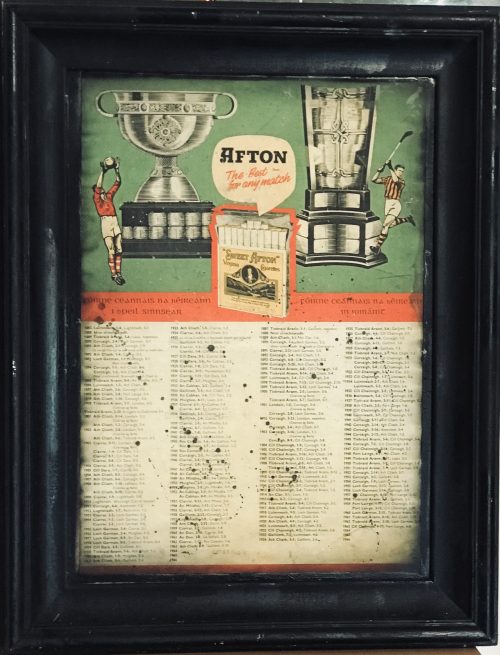 Fantastic original Sweet Afton Virginia Cigarettes Advertising print with beautiful images of the two holy grails in Irish Sport-The Sam Maguire Cup for the All Ireland Gaelic football Champions and the Liam McCarthy Cup for the All Ireland Hurling Champions.A footballer from Cork and a hurler from Kilkenny are featured in this charming print. Also the winners and shorelines from All Irelands from 1887 to 1963 are included underneath.Acharming addition to any wall space Dimensions: 75cm x 55cm Origins;Aughrim Co Galway UnglazedOrigins : Co Kilkenny Dimensions : 48cm x 62cm
Fantastic original Sweet Afton Virginia Cigarettes Advertising print with beautiful images of the two holy grails in Irish Sport-The Sam Maguire Cup for the All Ireland Gaelic football Champions and the Liam McCarthy Cup for the All Ireland Hurling Champions.A footballer from Cork and a hurler from Kilkenny are featured in this charming print. Also the winners and shorelines from All Irelands from 1887 to 1963 are included underneath.Acharming addition to any wall space Dimensions: 75cm x 55cm Origins;Aughrim Co Galway UnglazedOrigins : Co Kilkenny Dimensions : 48cm x 62cm A 20-pack of Sweet Afton cigarettes with a text warning in both Irish and English stating "Smoking kills".
A 20-pack of Sweet Afton cigarettes with a text warning in both Irish and English stating "Smoking kills".Product type Cigarette Sweet Afton was an Irish brand of short, unfiltered cigarettes made with Virginia tobacco and produced by P.J. Carroll & Co., Dundalk, Ireland, now a subsidiary of British American Tobacco. The Sweet Afton brand was launched by Carroll's in 1919 to celebrate the link between Dundalk and the national poet of Scotland, Robert Burns. Burns' eldest sister, Agnes, lived in Dundalk from 1817 until her death in 1834 and was buried in the cemetery of St. Nicholas's Church in the town. Carroll's thought that the brand would only be successful in Scotland if the carton simply had an image of Burns, or Scottish name on the packet, so the people of Dundalk were canvassed and the name Sweet Afton was chosen. The name is taken from Burns' poem "Sweet Afton", which itself takes its title from the poem's first stanza: Flow gently, sweet Afton, amang thy green braes Flow gently, I’ll sing thee a song in thy praise My Mary’s asleep by they murmuring stream Flow gently, sweet Afton, disturb not her dream. A larger version of the cigarette was also marketed under the brand name Afton Major. This name served as inspiration for Carroll's later Majorbrand of tipped cigarettes. As of Autumn 2011, British American Tobacco no longer manufactures Sweet Afton cigarettes. The text "Thank you for your loyalty, unfortunately Sweet Afton will not be available in the future. However Major, our other Irish brand with similar tobacco will still be widely available for purchase." was written on a sticker that was put on the last line of packs, before it went out of production. The brand proved particularly popular with post World War II Rive Gauche Paris. It was reputed to be Jean-Paul Sartre's preferred cigarette, and also featured prominently in Louis Malle's film Le Feu Follet, as well as a number of other Nouvelle Vague films.Margot Tenenbaum (played by Gwyneth Paltrow) from Wes Anderson's 2001 film The Royal Tenenbaums also smokes Sweet Aftons. Thomas Shelby, in Peaky Blinders, smokes Sweet Aftons. They are also the favoured brand of Gerhard Selb, the eponymous private investigator in the trilogy by Bernhard SchlinkOld Afton advertisement on a pub in Wexford -
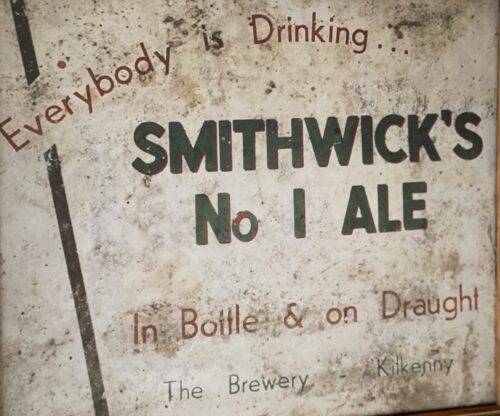
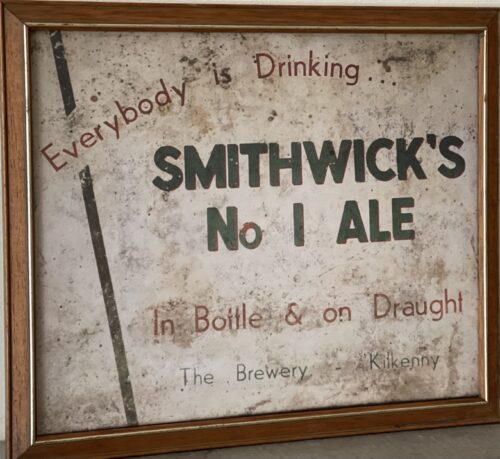 40cm x 34cm LimerickThe old Smithwicks brewery is on the site of a Franciscan abbey, where monks had brewed ale since the 14th century, and ruins of the original abbey still remain on its grounds. The old brewery has since been renovated and now hosts "The Smithwick's Experience Kilkenny" visitor attraction and centre.At the time of its closure, it was Ireland's oldest operating brewery. John Smithwick was an orphan who had settled in Kilkenny. Shortly after his arrival, Smithwick went into the brewing business with Richard Cole on a piece of land that Cole had leased from the Duke of Ormond in 1705. Five years later, John Smithwick became the owner of the land. The brewery stayed small, servicing a loyal local following while John Smithwick diversified. Following John Smithwick's death, the brewery temporarily fell out of family hands. John Smithwick's great grandson, Edmond bought the brewery land back freehold and worked to reshape its future. Edmond concentrated on discovering new markets and successfully building export trade. Drinkers in England, Scotland and Wales developed a taste for Smithwick's brews and output increased fivefold. As a result of substantial contributions made to St Mary's Cathedral, Edmond became great friends with Irish liberal Daniel O'Connell, who later became godfather to one of his sons. Edmond Smithwick became well known and respected by the people of Kilkenny who elected him town mayor four times. In 1800, export sales began to fall and the brewing industry encountered difficulty. To combat this, the Smithwick family increased production in their maltings, began selling mineral water and delivered butter with the ale from the back of their drays.By 1900, output was at an all-time low and the then owner James Smithwick was advised by auditors to shut the doors of the brewery. Instead, James reduced the range of beers they produced and set out to find new markets. He secured military contracts and soon after saw output increase again. James' son, Walter, took control in 1930 and steered the brewery to success through the hardships of both World War II and increasingly challenging weather conditions.By January 1950, Smithwick's was exporting ale to Boston.Smithwick's was purchased from Walter Smithwick in 1965 by Guinness and is now, along with Guinness, part of Diageo. Together, Guinness & Co. and Smithwick's developed and launched Smithwick's Draught Ale in 1966. By 1979, half a million barrels were sold each year.In 1980, Smithwick's began exporting to France. In 1993, Smithwick's Draught became Canada's leading imported ale.By 2010, Smithwick's continued to be brewed in Dundalk and Kilkenny with tankers sent to Dublin to be kegged for the on trade market. Cans and bottles were packaged by IBC in Belfast.Production in the Kilkenny brewery finished on 31 December 2013 and Smithwicks brands are now produced in the Diageo St.James' Gate brewery in Dublin.The original Kilkenny site was sold to Kilkenny County Council, with a small portion of the site dedicated to the opening of a visitor's centre, the "Smithwick's Experience Kilkenny".
40cm x 34cm LimerickThe old Smithwicks brewery is on the site of a Franciscan abbey, where monks had brewed ale since the 14th century, and ruins of the original abbey still remain on its grounds. The old brewery has since been renovated and now hosts "The Smithwick's Experience Kilkenny" visitor attraction and centre.At the time of its closure, it was Ireland's oldest operating brewery. John Smithwick was an orphan who had settled in Kilkenny. Shortly after his arrival, Smithwick went into the brewing business with Richard Cole on a piece of land that Cole had leased from the Duke of Ormond in 1705. Five years later, John Smithwick became the owner of the land. The brewery stayed small, servicing a loyal local following while John Smithwick diversified. Following John Smithwick's death, the brewery temporarily fell out of family hands. John Smithwick's great grandson, Edmond bought the brewery land back freehold and worked to reshape its future. Edmond concentrated on discovering new markets and successfully building export trade. Drinkers in England, Scotland and Wales developed a taste for Smithwick's brews and output increased fivefold. As a result of substantial contributions made to St Mary's Cathedral, Edmond became great friends with Irish liberal Daniel O'Connell, who later became godfather to one of his sons. Edmond Smithwick became well known and respected by the people of Kilkenny who elected him town mayor four times. In 1800, export sales began to fall and the brewing industry encountered difficulty. To combat this, the Smithwick family increased production in their maltings, began selling mineral water and delivered butter with the ale from the back of their drays.By 1900, output was at an all-time low and the then owner James Smithwick was advised by auditors to shut the doors of the brewery. Instead, James reduced the range of beers they produced and set out to find new markets. He secured military contracts and soon after saw output increase again. James' son, Walter, took control in 1930 and steered the brewery to success through the hardships of both World War II and increasingly challenging weather conditions.By January 1950, Smithwick's was exporting ale to Boston.Smithwick's was purchased from Walter Smithwick in 1965 by Guinness and is now, along with Guinness, part of Diageo. Together, Guinness & Co. and Smithwick's developed and launched Smithwick's Draught Ale in 1966. By 1979, half a million barrels were sold each year.In 1980, Smithwick's began exporting to France. In 1993, Smithwick's Draught became Canada's leading imported ale.By 2010, Smithwick's continued to be brewed in Dundalk and Kilkenny with tankers sent to Dublin to be kegged for the on trade market. Cans and bottles were packaged by IBC in Belfast.Production in the Kilkenny brewery finished on 31 December 2013 and Smithwicks brands are now produced in the Diageo St.James' Gate brewery in Dublin.The original Kilkenny site was sold to Kilkenny County Council, with a small portion of the site dedicated to the opening of a visitor's centre, the "Smithwick's Experience Kilkenny". -
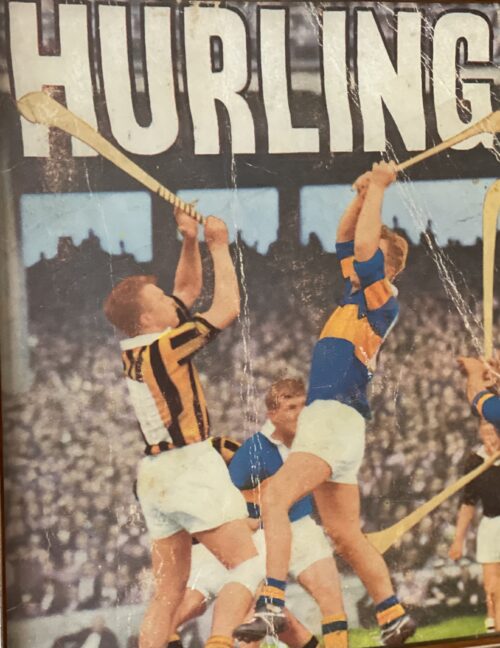
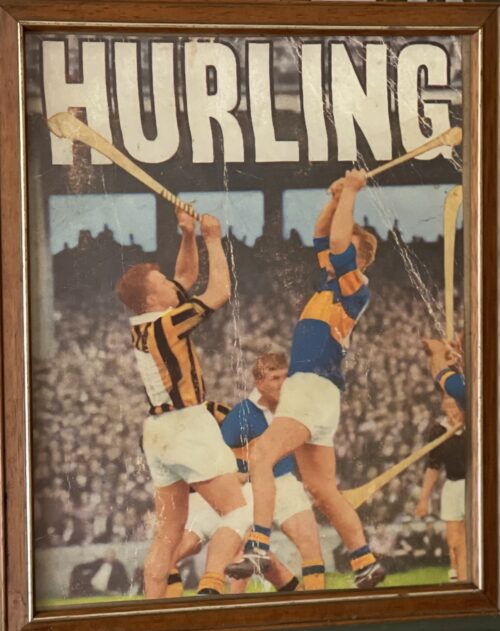 40cm x 34cm Hurling (Irish: iománaíocht, iomáint) is an outdoor team game of ancient Gaelic Irish origin, played by men. One of Ireland's native Gaelic games, it shares a number of features with Gaelic football, such as the field and goals, the number of players, and much terminology. There is a similar game for women called camogie (camógaíocht). It shares a common Gaelic root. The objective of the game is for players to use an ash wood stick called a hurley (in Irish a camán, pronounced /ˈkæmən/or /kəˈmɔːn/) to hit a small ball called a sliotar /ˈʃlɪtər/ between the opponents' goalposts either over the crossbar for one point, or under the crossbar into a net guarded by a goalkeeper for three points. The sliotar can be caught in the hand and carried for not more than four steps, struck in the air, or struck on the ground with the hurley. It can be kicked, or slapped with an open hand (the hand pass) for short-range passing. A player who wants to carry the ball for more than four steps has to bounce or balance the sliotar on the end of the stick, and the ball can only be handled twice while in the player’s possession. Provided that a player has at least one foot on the ground, a player may make a shoulder-to-shoulder charge on an opponent who is in possession of the ball or is playing the ball or when both players are moving in the direction of the ball to play it. No protective padding is worn by players. A plastic protective helmet with a faceguard is mandatory for all age groups, including senior level, as of 2010. The game has been described as "a bastion of humility", with player names absent from jerseys and a player's number decided by his position on the field. Hurling is administered by the Gaelic Athletic Association (GAA). It is played throughout the world, and is popular among members of the Irish diaspora in North America, Europe, Australia, New Zealand, South Africa, Argentina, and South Korea. In many parts of Ireland, however, hurling is a fixture of life.It has featured regularly in art forms such as film, music and literature. The final of the All-Ireland Senior Hurling Championship was listed in second place by CNN in its "10 sporting events you have to see live", after the Olympic Games and ahead of both the FIFA World Cup and UEFA European Championship.After covering the 1959 All-Ireland Senior Hurling Championship Final between Kilkenny and Waterford for BBC Television, English commentator Kenneth Wolstenholme was moved to describe hurling as his second favourite sport in the world after his first love, football.Alex Ferguson used footage of an All-Ireland Senior Hurling Championship final in an attempt to motivate his players during his time as manager of Premier League football club Manchester United; the players winced at the standard of physicality and intensity in which the hurlers were engaged. In 2007, Forbes magazine described the media attention and population multiplication of Thurles town ahead of one of the game's annual provincial hurling finals as being "the rough equivalent of 30 million Americans watching a regional lacrosse game".Financial Times columnist Simon Kuper wrote after Stephen Bennett's performance in the 2020 All-Ireland Senior Hurling Championship Final that hurling was "the best sport ever and if the Irish had colonised the world, nobody would ever have heard of football" UNESCO lists hurling as an element of Intangible cultural heritage.
40cm x 34cm Hurling (Irish: iománaíocht, iomáint) is an outdoor team game of ancient Gaelic Irish origin, played by men. One of Ireland's native Gaelic games, it shares a number of features with Gaelic football, such as the field and goals, the number of players, and much terminology. There is a similar game for women called camogie (camógaíocht). It shares a common Gaelic root. The objective of the game is for players to use an ash wood stick called a hurley (in Irish a camán, pronounced /ˈkæmən/or /kəˈmɔːn/) to hit a small ball called a sliotar /ˈʃlɪtər/ between the opponents' goalposts either over the crossbar for one point, or under the crossbar into a net guarded by a goalkeeper for three points. The sliotar can be caught in the hand and carried for not more than four steps, struck in the air, or struck on the ground with the hurley. It can be kicked, or slapped with an open hand (the hand pass) for short-range passing. A player who wants to carry the ball for more than four steps has to bounce or balance the sliotar on the end of the stick, and the ball can only be handled twice while in the player’s possession. Provided that a player has at least one foot on the ground, a player may make a shoulder-to-shoulder charge on an opponent who is in possession of the ball or is playing the ball or when both players are moving in the direction of the ball to play it. No protective padding is worn by players. A plastic protective helmet with a faceguard is mandatory for all age groups, including senior level, as of 2010. The game has been described as "a bastion of humility", with player names absent from jerseys and a player's number decided by his position on the field. Hurling is administered by the Gaelic Athletic Association (GAA). It is played throughout the world, and is popular among members of the Irish diaspora in North America, Europe, Australia, New Zealand, South Africa, Argentina, and South Korea. In many parts of Ireland, however, hurling is a fixture of life.It has featured regularly in art forms such as film, music and literature. The final of the All-Ireland Senior Hurling Championship was listed in second place by CNN in its "10 sporting events you have to see live", after the Olympic Games and ahead of both the FIFA World Cup and UEFA European Championship.After covering the 1959 All-Ireland Senior Hurling Championship Final between Kilkenny and Waterford for BBC Television, English commentator Kenneth Wolstenholme was moved to describe hurling as his second favourite sport in the world after his first love, football.Alex Ferguson used footage of an All-Ireland Senior Hurling Championship final in an attempt to motivate his players during his time as manager of Premier League football club Manchester United; the players winced at the standard of physicality and intensity in which the hurlers were engaged. In 2007, Forbes magazine described the media attention and population multiplication of Thurles town ahead of one of the game's annual provincial hurling finals as being "the rough equivalent of 30 million Americans watching a regional lacrosse game".Financial Times columnist Simon Kuper wrote after Stephen Bennett's performance in the 2020 All-Ireland Senior Hurling Championship Final that hurling was "the best sport ever and if the Irish had colonised the world, nobody would ever have heard of football" UNESCO lists hurling as an element of Intangible cultural heritage. -
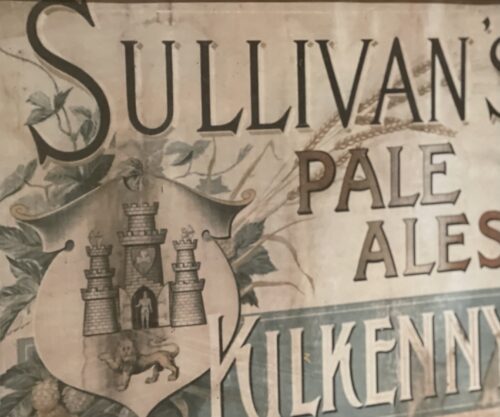
 37cm x 47cm Limerick Sullivan’s Brewing Company opened for business over three hundred years ago in The Maltings on James’s Street, smack bang in the middle of Kilkenny City.
37cm x 47cm Limerick Sullivan’s Brewing Company opened for business over three hundred years ago in The Maltings on James’s Street, smack bang in the middle of Kilkenny City.Up until the early 1700s, brewing on a large scale was a rarity, this resulted in many small breweries springing up all around the country, with little or no consistency in the beer that was being produced. Back then, to guarantee that each pint was as good as the last, required brewing on a bigger, more exacting scale.
Enter Mr. Sullivan, a man of high morals, integrity and a good nose for great beer. Through his belief and hard work he established a brewery the likes of which had never been seen in Kilkenny. He only used the very best local ingredients and the very best brewing methods to ensure that every barrel of Sullivan’s Red Ale that left his brewery was as good as the one that had gone before.
Richard Sullivan was elected to represent the people of Kilkenny in the 1820s. This supposedly put one well-known Irish political figure’s nose well and truly out of joint – Daniel O’Connell.After one particularly heated parliamentary quarrel, O’Connell even called a boycott of Sullivan’s Ale by the people of Kilkenny. But you’ll know if you’ve ever had a pint of Sullivan’s Red Ale in front of you that it can be very hard to resist, and the boycott was soon called off.
Despite this rocky start, Richard and Daniel went on to become firm friends. So good in fact, that when O’Connell was stripped of his seat in Parliament due to some underhand dealings, Sullivan was one of the few who had his back. He wrote to Daniel and offered him his seat to ensure that O’Connell’s Catholic Emancipation Act would get through Parliament.
1802MIXING BUSINESS AND POLITICSGOOD WILL, KINDNESS AND HOT SOUP
1880 was the year of ‘The Great Sullivan’s Brewery Fire’, a day that has gone down in legend among the people of Kilkenny.The story goes that the Sullivan Family took the day off brewing to attend the funeral of a recently departed family friend in a Kilkenny hilltop chapel. Leaving a funeral before all the formalities were completed was the height of bad manners. The Sullivans could see the brewery ablaze from the hillside, but could do nothing about it.
As the first flames began to lick the outside of the brewery, the alarm was raised and the local fire brigade was sent for. But The Kilkenny Fire Brigade consisted of a few volunteers, a horse and a cart and a useless, leaking hose. Due to all their good deeds over the years, the Sullivans were a tremendously popular family in Kilkenny, so men, women and children from far and wide rallied together and grabbed the nearest buckets, pales and pots, filling them with water and battling the fire. Within an hour the fire was under control and the brewery was saved, all because a community came together.
1880A COMMUNITY WORKING TOGETH1918
BLACK SHEEP AND THE LOST WAGER
After Sullivan’s Brewery closed for the final time in the early 1900s the tales of the good deeds of this Sullivan Family began to fade into memory.
Over the coming decades, the independent breweries that were once synonymous with Kilkenny began to drop off one by one, until its final working brewery sadly closed its doors in 2013. However, there wasn’t long to wait for a change of fortunes for Kilkenny-brewed ale, as 2016 saw two great families coming together to return traditional Irish brewing to its spiritual home.
The Smithwick Family in partnership with direct descendants of the Sullivan Family had a vision to re-open the once-great brewery in the city where it all began. They enlisted the help of Ian Hamilton, one of Ireland’s most eminent contemporary master-brewers. Together they are bringing artisan brewing back to Kilkenny.
If people thought that brewing in Kilkenny was dead and buried, they are in for a rude awakening…
2016
TWO GREAT FAMILIES AND THE RETURN OF SULLIVANS
WE’RE BACK AND HERE TO STAY
-

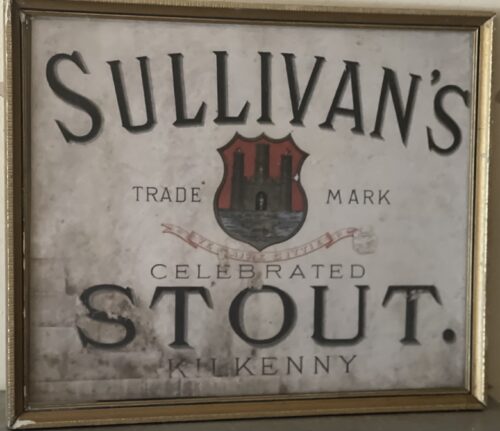 40cm x 34cm Limerick Sullivan’s Brewing Company opened for business over three hundred years ago in The Maltings on James’s Street, smack bang in the middle of Kilkenny City.
40cm x 34cm Limerick Sullivan’s Brewing Company opened for business over three hundred years ago in The Maltings on James’s Street, smack bang in the middle of Kilkenny City.Up until the early 1700s, brewing on a large scale was a rarity, this resulted in many small breweries springing up all around the country, with little or no consistency in the beer that was being produced. Back then, to guarantee that each pint was as good as the last, required brewing on a bigger, more exacting scale.
Enter Mr. Sullivan, a man of high morals, integrity and a good nose for great beer. Through his belief and hard work he established a brewery the likes of which had never been seen in Kilkenny. He only used the very best local ingredients and the very best brewing methods to ensure that every barrel of Sullivan’s Red Ale that left his brewery was as good as the one that had gone before.
Richard Sullivan was elected to represent the people of Kilkenny in the 1820s. This supposedly put one well-known Irish political figure’s nose well and truly out of joint – Daniel O’Connell.After one particularly heated parliamentary quarrel, O’Connell even called a boycott of Sullivan’s Ale by the people of Kilkenny. But you’ll know if you’ve ever had a pint of Sullivan’s Red Ale in front of you that it can be very hard to resist, and the boycott was soon called off.
Despite this rocky start, Richard and Daniel went on to become firm friends. So good in fact, that when O’Connell was stripped of his seat in Parliament due to some underhand dealings, Sullivan was one of the few who had his back. He wrote to Daniel and offered him his seat to ensure that O’Connell’s Catholic Emancipation Act would get through Parliament.
1802MIXING BUSINESS AND POLITICSGOOD WILL, KINDNESS AND HOT SOUP
1880 was the year of ‘The Great Sullivan’s Brewery Fire’, a day that has gone down in legend among the people of Kilkenny.The story goes that the Sullivan Family took the day off brewing to attend the funeral of a recently departed family friend in a Kilkenny hilltop chapel. Leaving a funeral before all the formalities were completed was the height of bad manners. The Sullivans could see the brewery ablaze from the hillside, but could do nothing about it.
As the first flames began to lick the outside of the brewery, the alarm was raised and the local fire brigade was sent for. But The Kilkenny Fire Brigade consisted of a few volunteers, a horse and a cart and a useless, leaking hose. Due to all their good deeds over the years, the Sullivans were a tremendously popular family in Kilkenny, so men, women and children from far and wide rallied together and grabbed the nearest buckets, pales and pots, filling them with water and battling the fire. Within an hour the fire was under control and the brewery was saved, all because a community came together.
1880A COMMUNITY WORKING TOGETH1918
BLACK SHEEP AND THE LOST WAGER
After Sullivan’s Brewery closed for the final time in the early 1900s the tales of the good deeds of this Sullivan Family began to fade into memory.
Over the coming decades, the independent breweries that were once synonymous with Kilkenny began to drop off one by one, until its final working brewery sadly closed its doors in 2013. However, there wasn’t long to wait for a change of fortunes for Kilkenny-brewed ale, as 2016 saw two great families coming together to return traditional Irish brewing to its spiritual home.
The Smithwick Family in partnership with direct descendants of the Sullivan Family had a vision to re-open the once-great brewery in the city where it all began. They enlisted the help of Ian Hamilton, one of Ireland’s most eminent contemporary master-brewers. Together they are bringing artisan brewing back to Kilkenny.
If people thought that brewing in Kilkenny was dead and buried, they are in for a rude awakening…
2016
TWO GREAT FAMILIES AND THE RETURN OF SULLIVANS
WE’RE BACK AND HERE TO STAY




